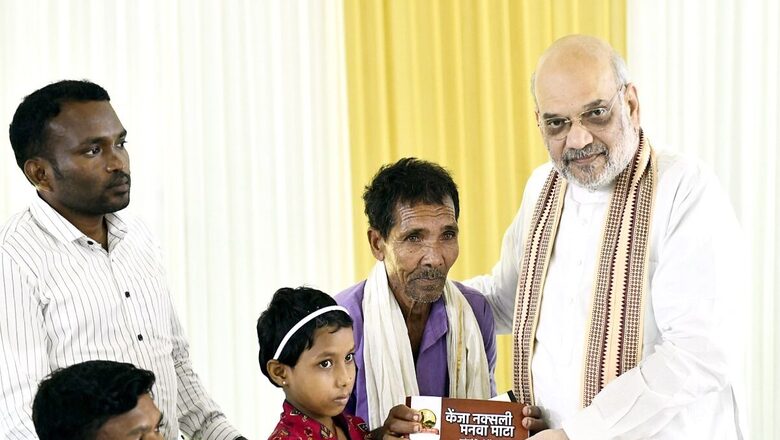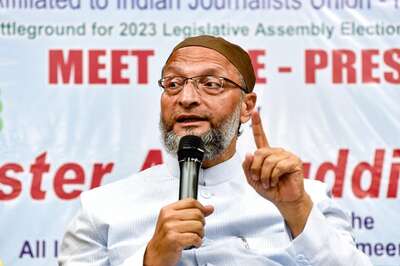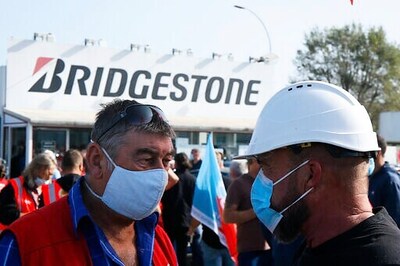
views
Amid ongoing anti-Naxal operations, the RSS-BJP combine has launched a new social campaign to rally support for victims of Maoist violence. A committee, Bastar Shanti Samiti, has been formed to unite and assist these victims. In a major move, Chhattisgarh’s home minister Vijay Sharma led 55 victims to Delhi, where they met union home minister Amit Shah on Thursday and were scheduled to meet the President of India on Saturday before returning to Raipur. Of these 55 victims, 37 have lost their limbs or eyesight in IED blasts while the rest have lost their family members in the violence.
This move seems crucial as it signals an intensified crackdown on Naxal activity and more anti-Naxal operations in the Bastar region, with Amit Shah reportedly assuring victims that the guerrillas will be flushed out by March 31, 2025.
Shah also promised multiple schemes to support victims who lost limbs in IED blasts or family members in attacks, emphasising the government’s commitment to both eradicating Naxalism and rehabilitating survivors. This marks a strategic shift—combining military action with emotional outreach to strengthen their position.
Operations to intensify
Later, on social media platform X, Shah stated, “I am deeply moved after interacting with the brothers and sisters affected by Naxalite violence in Chhattisgarh. I assure all of you that the Modi Government is committed to eradicating Naxalism completely within two years and restoring peace in your region.”
Lambasting Naxalites, he added, “Naxalism follows the ideology of destruction and violence. Hiding behind the guise of human rights to garner sympathy for themselves has been a consistent strategy of the Naxalites. The wounds of those affected by the violence in Naxal-impacted areas are living symbols of the inhumanity and brutality of Naxalism.”
Over the past eight months, around 150 Naxalites, including at least 55 young women cadres, were killed during anti-Naxal operations by security forces in Bastar. Meanwhile, there have been several instances of IED blasts, attacks on the security forces and other forms of Naxal violence in the region.
Sharma, in an earlier interview with News 18, said that the ongoing flush-out operations in Bastar are based on verified intelligence inputs to avoid any misunderstandings or confusion. He added that the state government is ready to initiate “unconditional” dialogue with the Naxals. He asserted that poor tribal villagers are coerced or enticed into taking up arms, resisting development, and remaining isolated from the mainstream by “urban Naxals” residing in cities like Delhi.
Surviving in silence
The stories of septuagenarian Dayalu Ram, Khartam Jogakka, and Marvi Nanduram reflect the stealth and resilience of ordinary tribal villagers in the face of unrelenting Naxal violence in Chhattisgarh. In 2022, Khartam Jogakka, a mother of four daughters and a son from Medlecheru, Bijapur, lost her right leg in a landmine blast—a tragic consequence of the Naxal conflict that has engulfed the region. She, like all villagers, went inside the forest to gather firewood when the IED went off.
Despite this life-altering injury, Jogakka refuses to succumb to despair. “The land is fraught with danger, but we learn to live with it,” she told News18 in Delhi while standing with the help of a crutch.
For Dayalu Ram from Kanker, the loss was even more personal and brutal. His son was mercilessly chopped to death, a horrifying casualty of the violence that continues to claim innocent lives. Dayalu’s grief is profound, but beneath it lies a simmering strength. While narrating the incident, he broke down. He was asleep at his hut at night, when a group of gun-wielding Naxals barged in, dragged his son out and chopped him to death in front of his whole family.
“We have no choice but to stand tall, even when the world around us falls apart,” he said. Even though the trauma and scars are deep, his voice was carrying the weight of countless fathers who had buried their children in this conflict.
Similarly, Marvi Nanduram’s life was irrevocably changed by a bomb blast in Sukma. Caught in the crossfire between the state and Naxal forces, he grapples with the constant threat of violence. He lost both his eyes and hearing power after he stepped on a landmine in his field. He used to cultivate his small piece of land, and on the day of the incident, he was doing the same. However, the forest, the village roads and the fields are rigged with landmines across the Bastar region. “We live quietly, moving like shadows in our own land, and we are always scared of those invisible monsters,” Marvi said.
For the past four decades, the people of Bastar, Chhattisgarh, have been living under the shadow of Maoist terror, which has deeply affected the lives of millions in the region. Thousands of innocent villagers have lost their lives due to Maoist violence, while those who have survived bear the scars of trauma, having lost limbs and been left disabled.
Jairam Das, a representative of the Bastar Shanti Samiti, presented statistics revealing that over the past two and a half decades, more than 8,000 villagers have been killed by Maoists, while thousands more have been left disabled by landmines and IEDs. Many tribal villagers have lost limbs, their eyesight, or their hearing as a result of Maoist violence, a tragedy that affects not only the youth and men but also women, the elderly, and even children.



















Comments
0 comment